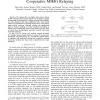Free Online Productivity Tools
i2Speak
i2Symbol
i2OCR
iTex2Img
iWeb2Print
iWeb2Shot
i2Type
iPdf2Split
iPdf2Merge
i2Bopomofo
i2Arabic
i2Style
i2Image
i2PDF
iLatex2Rtf
Sci2ools
104
click to vote
VTC
2008
IEEE
2008
IEEE
System Performance Analysis of Single-Path and Cooperative MIMO Relaying
— The demand for even higher data rates in future mobile communications systems calls for new techniques capable of improving the performance of cellular systems. One possibility are relay enhanced cells where additional radio access points without wired backhaul are mounted and served by a base station using in-band resources. Although relaying can significantly improve channel conditions in terms of pathloss and fading, it suffers from a limited link between base station and relay node as well as from the half-duplex operation in which relay nodes retransmit messages. In this work we discuss and evaluate relaying strategies for multiple antenna based systems in terms of average user throughput. The performance of a conventional cellular system is compared with single-path relaying and cooperative relaying where base stations and relay nodes cooperatively serve user terminals.
Related Content
| Added | 01 Jun 2010 |
| Updated | 01 Jun 2010 |
| Type | Conference |
| Year | 2008 |
| Where | VTC |
| Authors | Peter Rost, Fredrik Boye, Gerhard Fettweis |
Comments (0)

